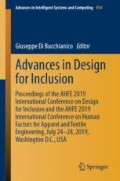Abstract
Electronic vending machines are a wide-spread system for delivering and accessing goods: the possibility of operating in a completely automated fashion and independently from business hours makes them extremely convenient for serving public and private locations. However, they fail their purpose in serving individuals with special needs: their lack of accessibility prevents users who are blind or have severe visual impairments from autonomously purchasing products. In this paper, we focus on the ergonomics of electronic vending machines and their automatic payment systems: we discuss their human factors and, specifically, usability to individuals who have severe low vision. Furthermore, we present a user experience analysis of their components and we detail the results of a study that evaluated the performance of different common types of commercially-available vending machines in the three steps of a purchase, that is, product selection, payment, and collection. Our results demonstrate that poor design, lack of tactile information, and absence of non-visual feedback have a significant impact on accessibility and prevent most customers who are blind from being able to independently select, pay, and collect a product.
Access this chapter
Tax calculation will be finalised at checkout
Purchases are for personal use only
References
Anything Research: 2019 U.S. Industry Statistics & Market Research - Vending Machine Operators (2019)
Caporusso, N., Trizio, M., Perrone, G.: Pervasive assistive technology for the deaf-blind need, emergency and assistance through the sense of touch. In: Pervasive Health, pp. 289–316. Springer, London (2014). https://doi.org/10.1007/978-1-4471-6413-5_12
Caporusso, N.: Issues, challenges and practices in advancing pervasive human-computer interaction for people with combined hearing and vision impairments (2012). http://e-theses.imtlucca.it/87/
ADA: Revised Regulations Implementing Title II and Title III (2013). https://www.ada.gov/regs2010/ADAregs2010.htm
Launey, K.M., Vu, M.N.: Justice Department Says Vending Machines Are Not Places of Public Accommodation—And So Much More. ADA Title III News & Insights (2017). https://www.adatitleiii.com/2017/07/justice-department-says-vending-machines-are-not-places-of-public-accommodation-and-so-much-more/
Tutuncu, O., Lieberman, L.: Accessibility of hotels for people with visual impairments: from research to practice. J. Vis. Impairment Blindness 110(3), 163–175 (2016)
Fusco, G., Tekin, E., Giudice, N.A., Coughlan, J.M.: Appliance displays: accessibility challenges and proposed solutions. In: Proceedings of the 17th International ACM SIGACCESS Conference on Computers & Accessibility, pp. 405–406. ACM, October 2015
Caporusso, N., Biasi, L., Cinquepalmi, G., Trotta, G.F., Brunetti, A., Bevilacqua, V.: Enabling touch-based communication in wearable devices for people with sensory and multisensory impairments. In: International Conference on Applied Human Factors and Ergonomics, pp. 149–159. Springer, Cham, July 2017. https://doi.org/10.1007/978-3-319-60639-2_15
Veijalainen, A.: Breaking barriers: accessible self-service kiosks for everyone (2017)
Darzentas, J., Petrie, H.: Standards, guidelines and legislation related to self-service technologies: developments since 2013. In: International Conference on Computers Helping People with Special Needs, pp. 295–302. Springer, Cham, July 2018
Vu, M.N., Sarnoff, J.N.: Websites, kiosks, and other self-service equipment in franchising: legal pitfalls posed by title III of the Americans with Disabilities Act. Franchise Law J. 36(3), 443 (2017)
Caporusso, N., Mkrtchyan, L., Badia, L.: A multimodal interface device for online board games designed for sight-impaired people. IEEE Trans. Inf. Technol. Biomed. 14(2), 248–254 (2010). https://doi.org/10.1109/TITB.2009.2034739
Caporusso, N., Biasi, L., Cinquepalmi, G., Trotta, G.F., Brunetti, A., Bevilacqua, V.: A wearable device supporting multiple touch-and gesture-based languages for the deaf-blind. In: International Conference on Applied Human Factors and Ergonomics, pp. 32–41. Springer, Cham, July 2017. https://doi.org/10.1007/978-3-319-60639-2_4
Bevilacqua, V., Biasi, L., Pepe, A., Mastronardi, G., Caporusso, N.: A computer vision method for the italian finger spelling recognition. In: International Conference on Intelligent Computing, pp. 264–274. Springer, Cham, August 2015. https://doi.org/10.1007/978-3-319-22053-6_28
Loconsole, C., Leonardis, D., Brunetti, A., Trotta, G., Caporusso, N., Bevilacqua, V.: Braille lab: a new design approach for social entrepreneurship and innovation in assistive tools for the visually impaired. World Acad. Sci. Eng. Technol. Int. Sci. Index Industr. Manuf. Eng. 11(5), 1252 (2017)
Sandnes, F.E.: Improving the robustness to input errors on touch-based self-service kiosks and transportation apps. In: International Conference on Computers Helping People with Special Needs, pp. 311–319. Springer, Cham, July 2018
Transit Cooperative Research Program: Accessibility of Automated Fare Vending and Collection for Customers with Disabilities. Transportation Research Board (1998)
Paul, A.M., Flynn, C.G.L., Panneton, J., Komissar, J.I.: Improving Accessibility of Public Transport Information for the Blind (2018)
Schreder, G., Siebenhandl, K., Mayr, E., Smuc, M.: The ticket machine challenge: social inclusion by barrier-free ticket vending machines. In: Generational Use of New Media, pp. 129–148 (2016)
Author information
Authors and Affiliations
Corresponding author
Editor information
Editors and Affiliations
Rights and permissions
Copyright information
© 2020 Springer Nature Switzerland AG
About this paper
Cite this paper
Caporusso, N., Udenze, K., Imaji, A., Cui, Y., Li, Y., Romeiser, S. (2020). Accessibility Evaluation of Automated Vending Machines. In: Di Bucchianico, G. (eds) Advances in Design for Inclusion. AHFE 2019. Advances in Intelligent Systems and Computing, vol 954. Springer, Cham. https://doi.org/10.1007/978-3-030-20444-0_5
Download citation
DOI: https://doi.org/10.1007/978-3-030-20444-0_5
Published:
Publisher Name: Springer, Cham
Print ISBN: 978-3-030-20443-3
Online ISBN: 978-3-030-20444-0
eBook Packages: EngineeringEngineering (R0)

